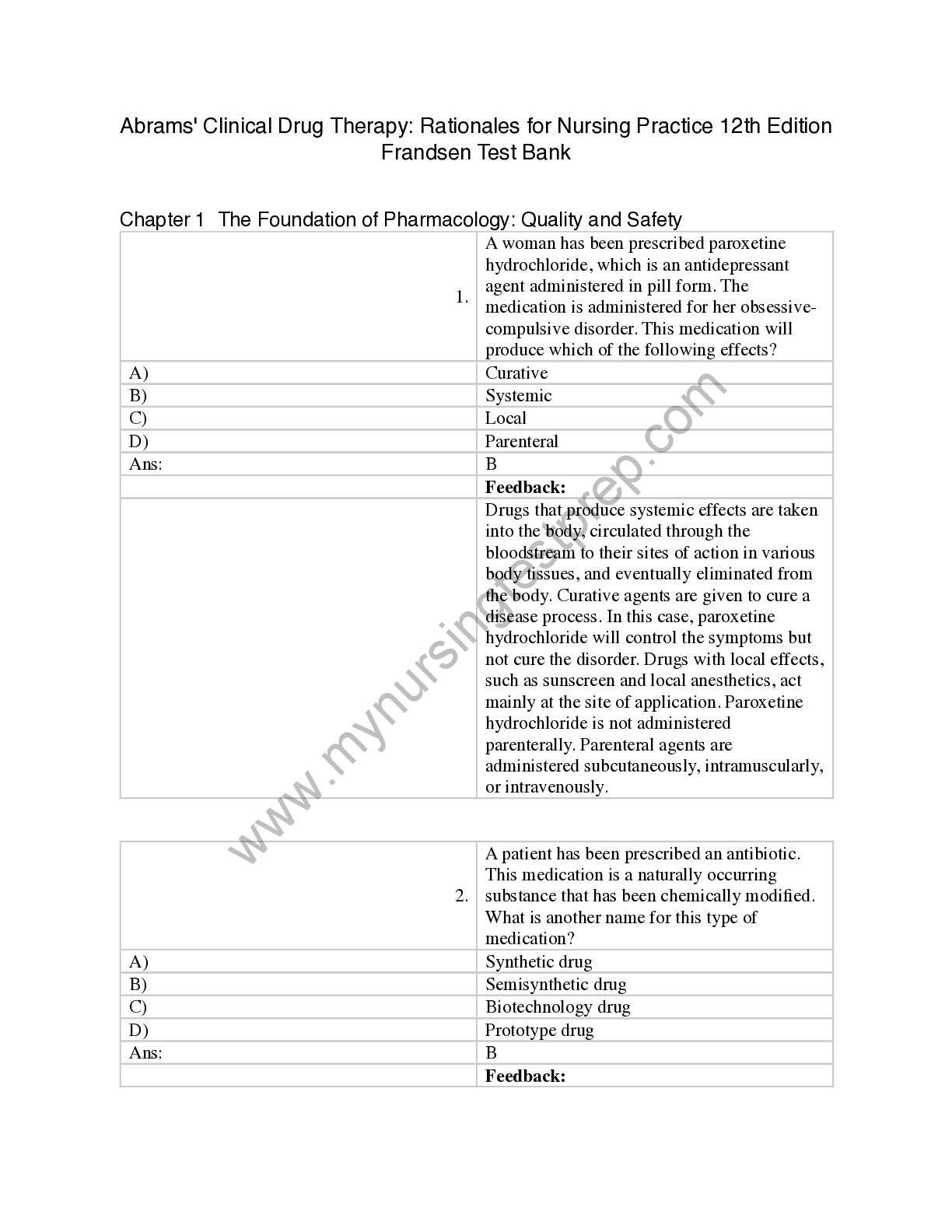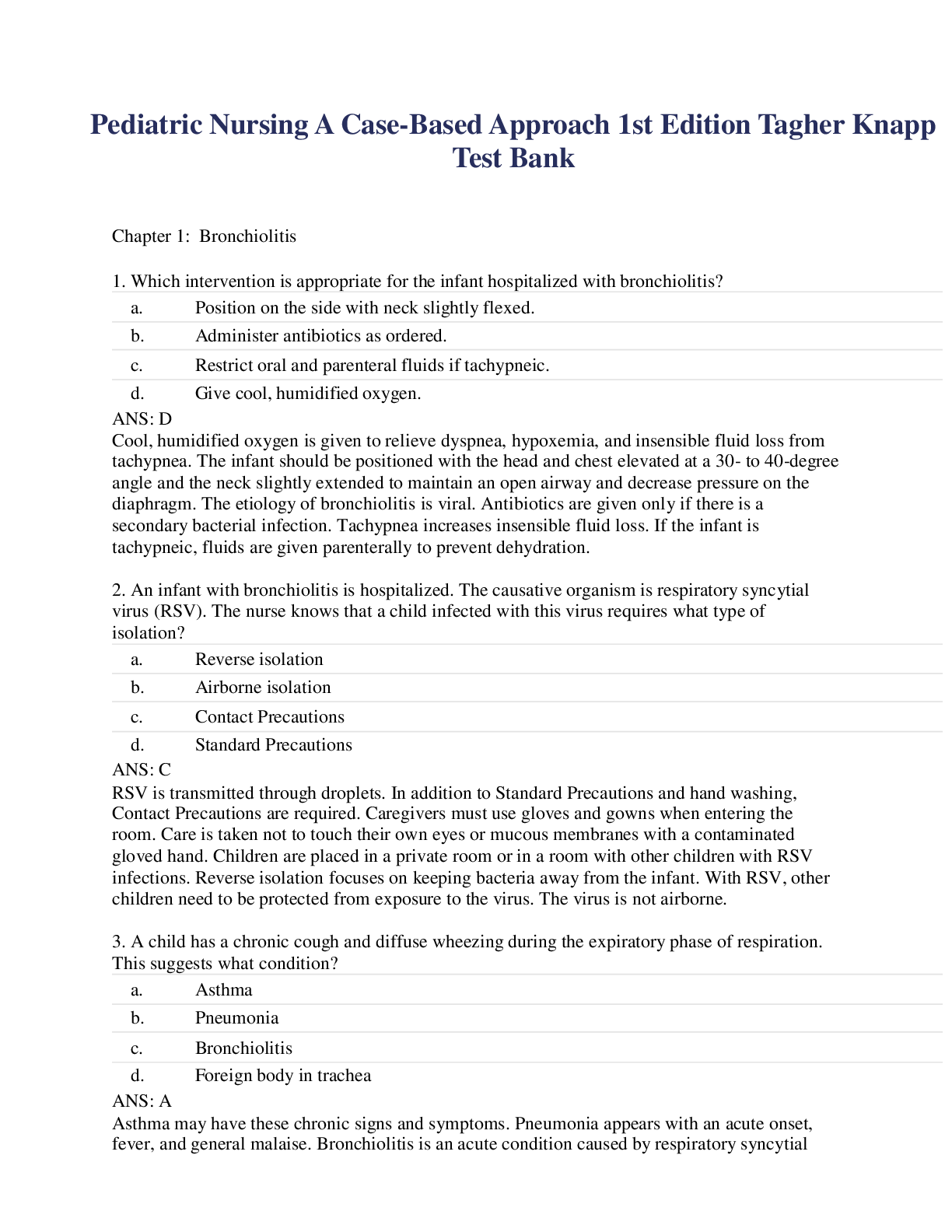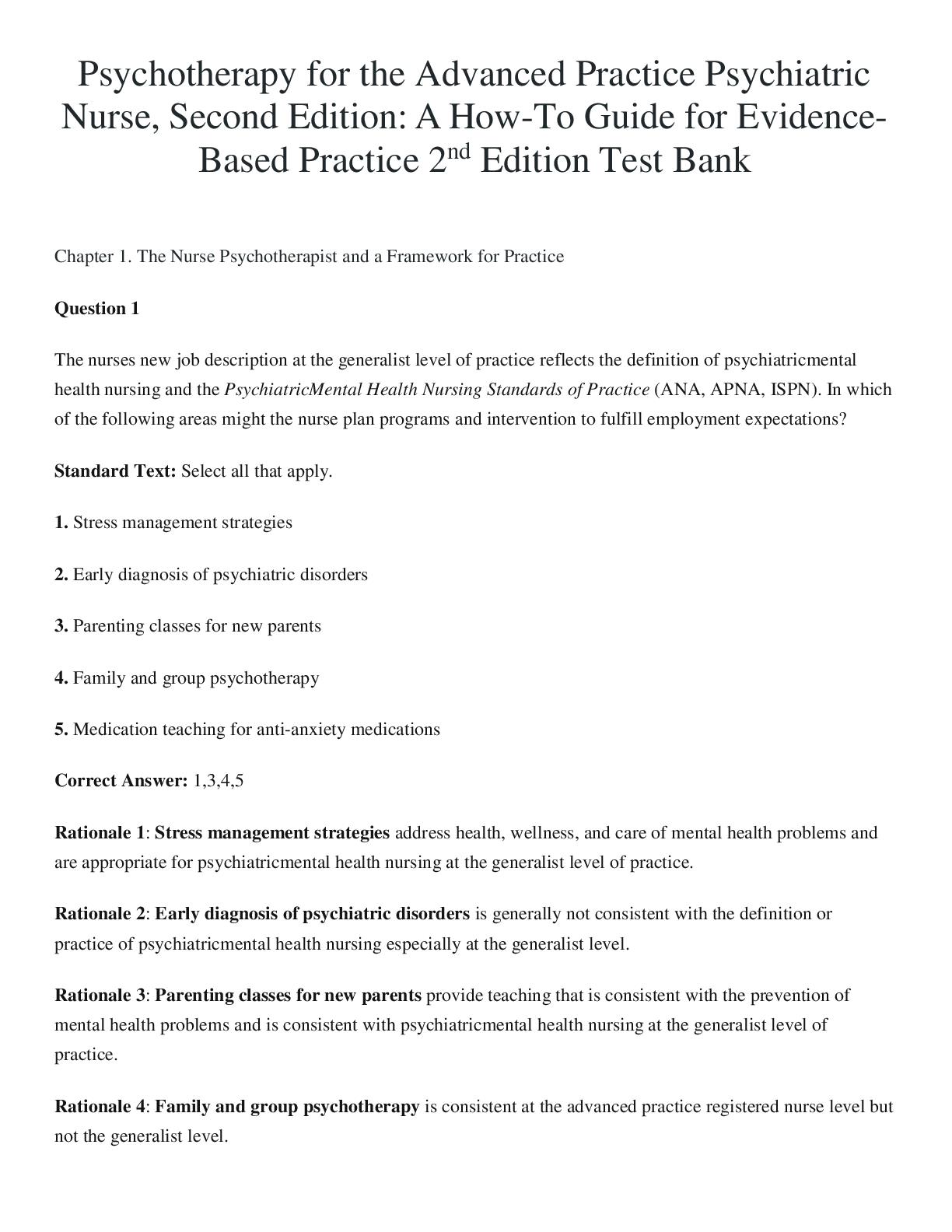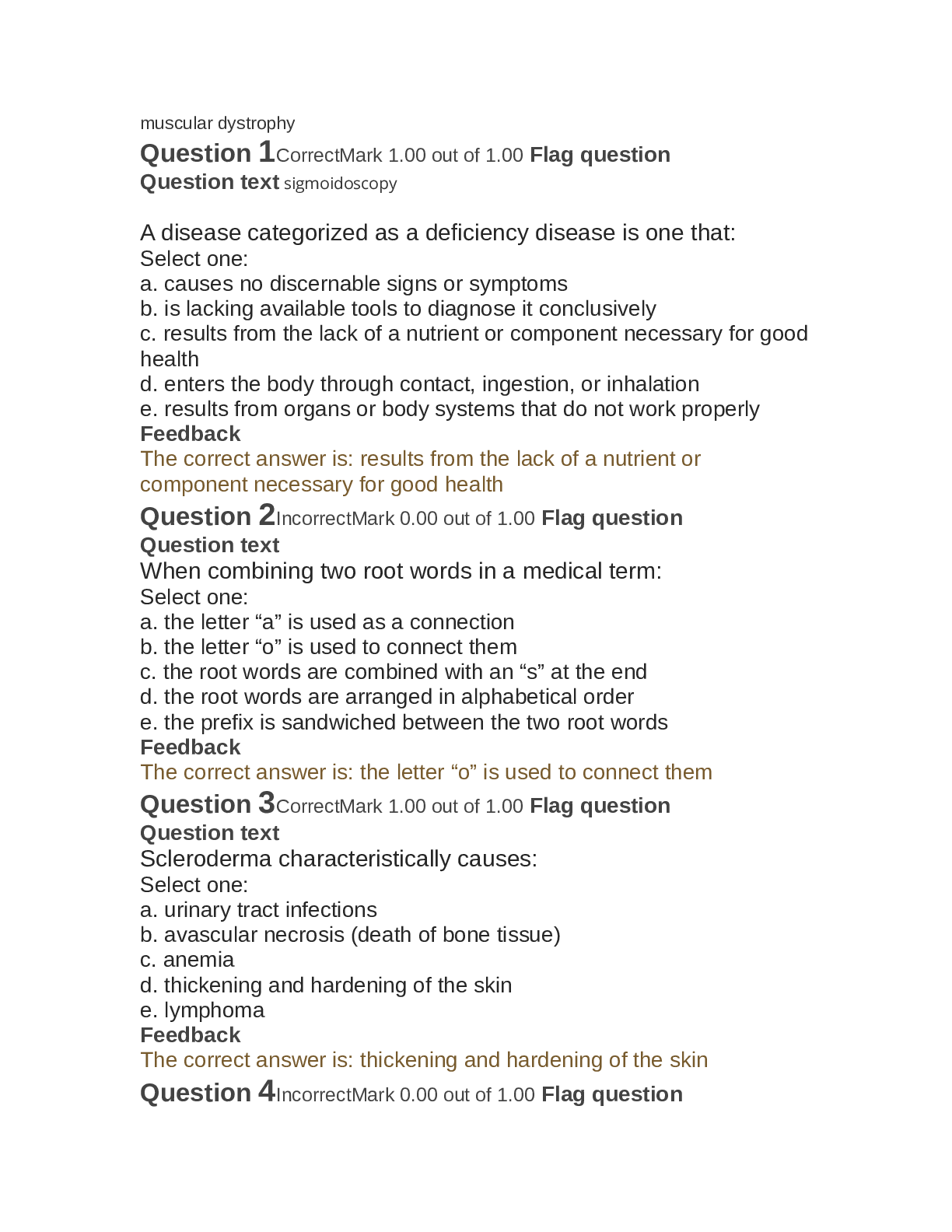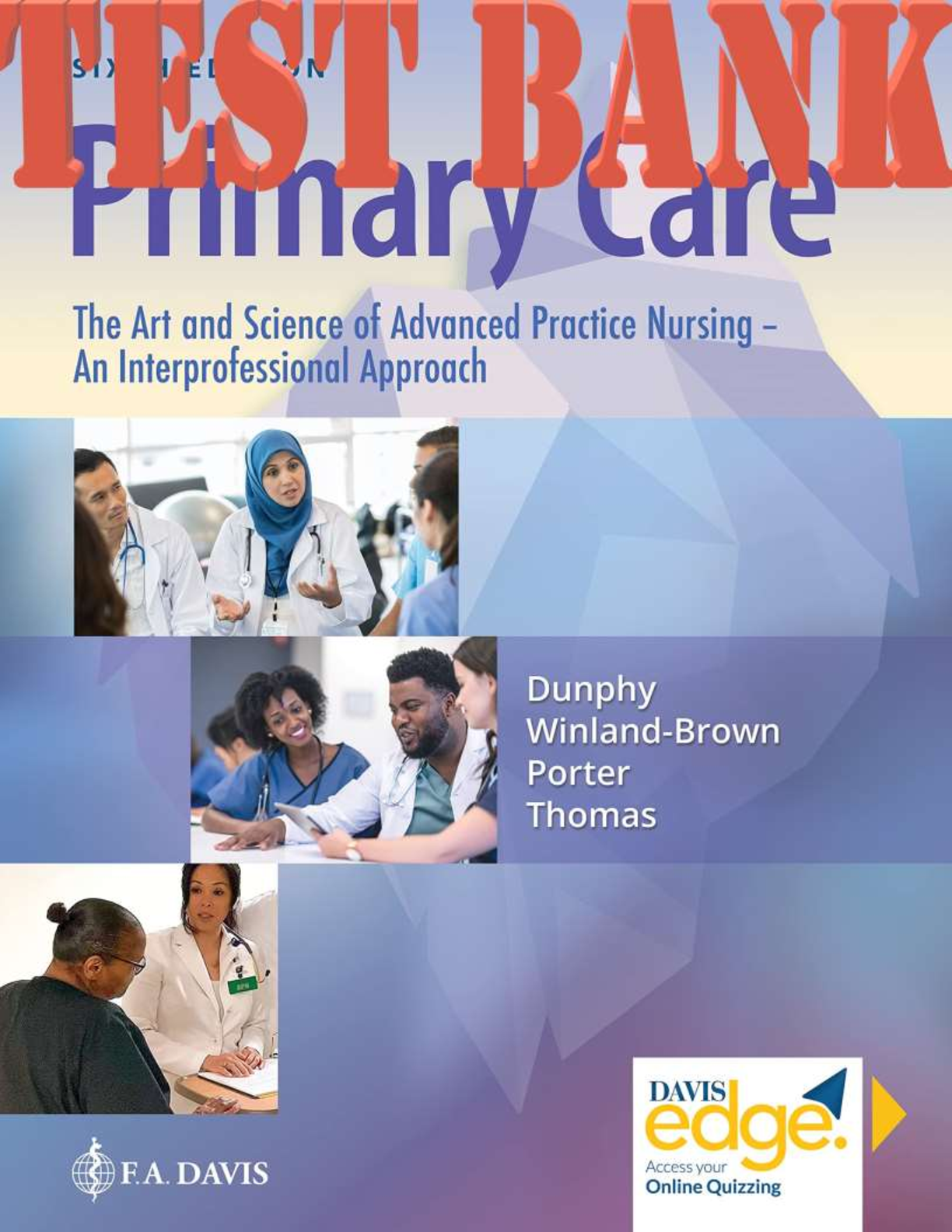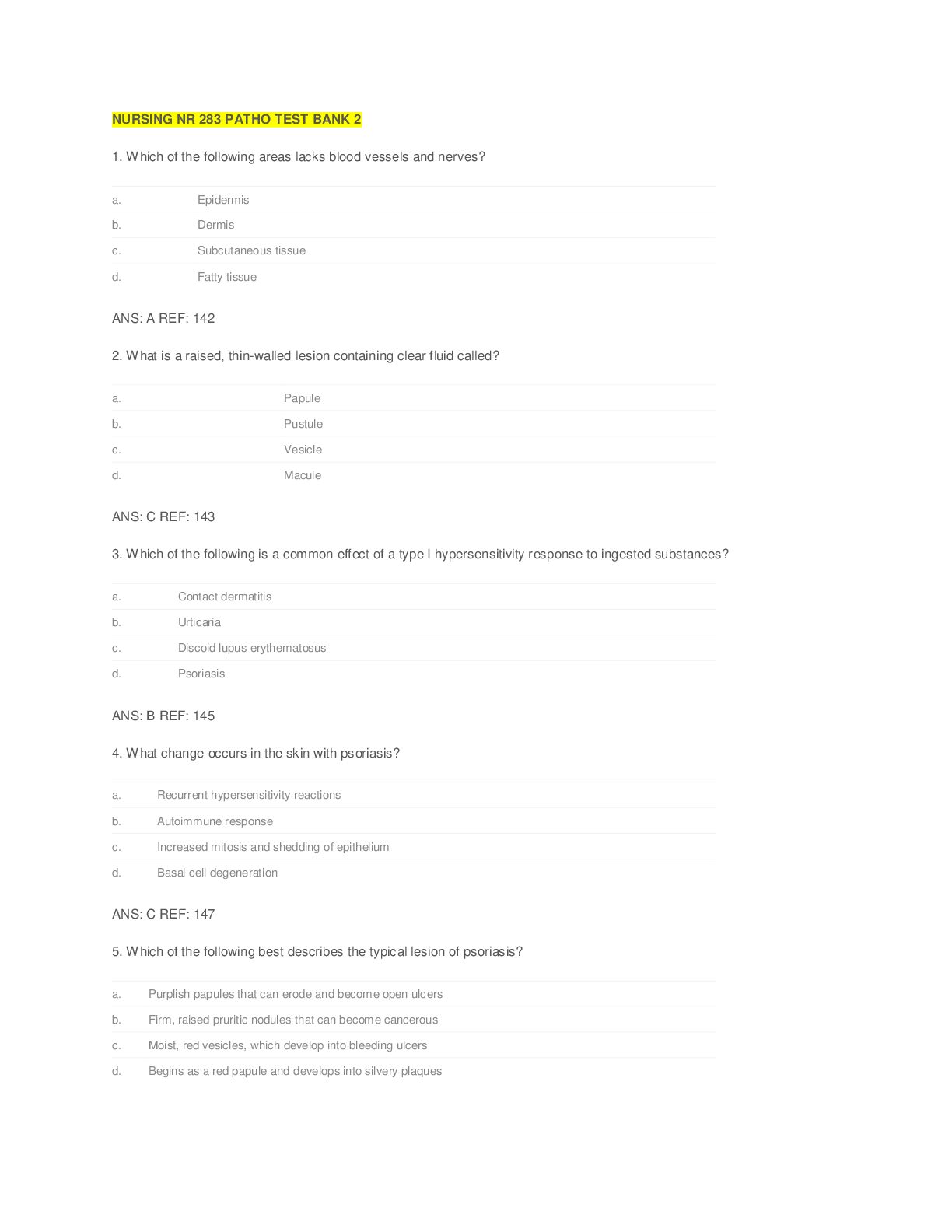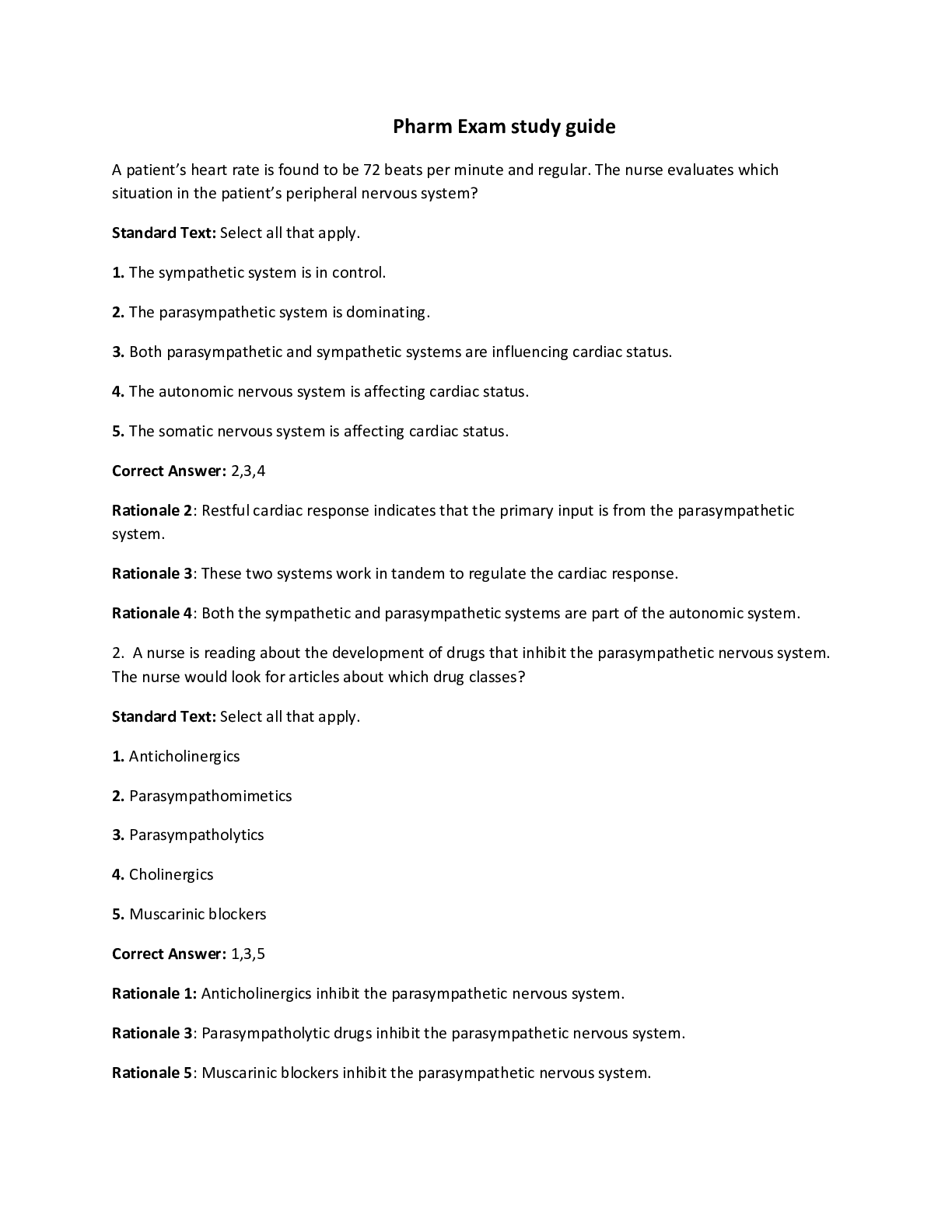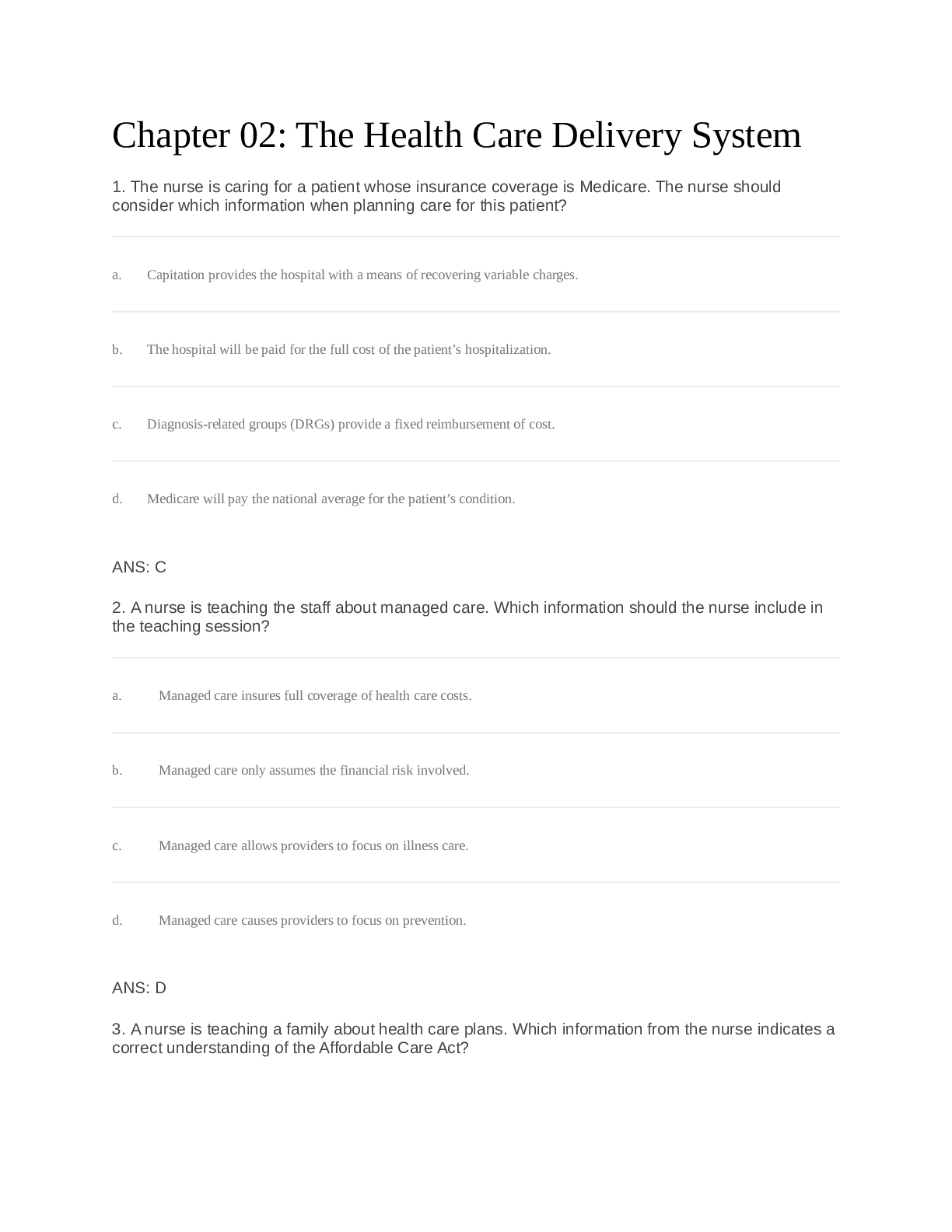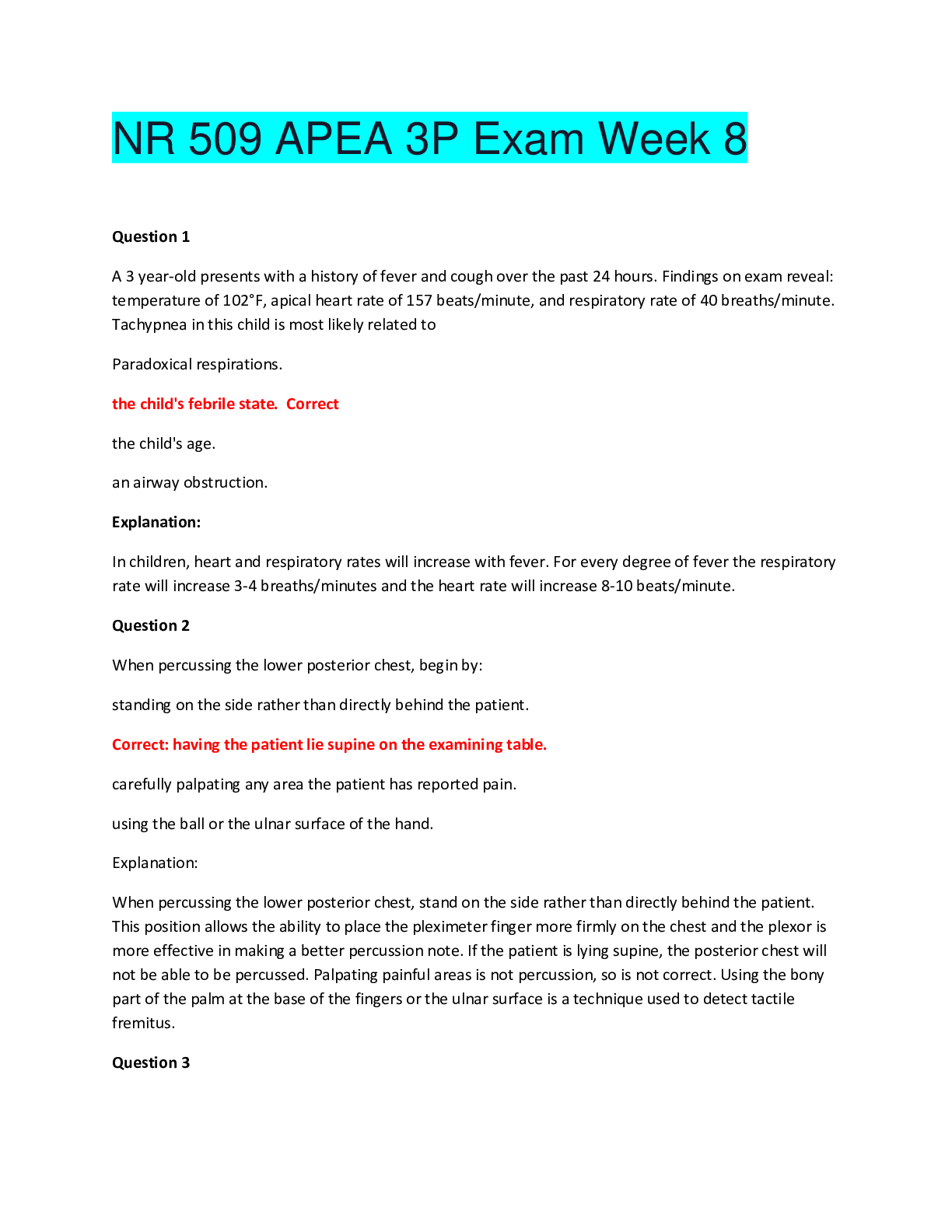Music > TEST BANK > TEST BANK Jazz Essential Listening by John Murphy - UNIVERSITY OF NORTH TEXAS (All)
TEST BANK Jazz Essential Listening by John Murphy - UNIVERSITY OF NORTH TEXAS
Document Content and Description Below
TEST BANK Jazz Essential Listening by John Murphy UNIVERSITY OF NORTH TEXAS B W • W • NORTON & COMPANY • NEW YORK • LONDON W. W. Norton & Company, Inc., 500 Fifth Avenue, New York, N.... Y. 10110 wwnorton .com W. W. Norton & Company Ltd., Castle House, 75/76 Wells Street, London, W1T 3QT 1 2 3 4 5 6 7 8 9 0 W. W. Norton & Company has been independent since its founding in 1923, when William Warder Norton and Mary D. Herter Norton fi rst published lectures delivered at the People’s Institute, the adult education division of New York City’s Cooper Union. The fi rm soon expanded its program beyond the Institute, publishing books by celebrated academics from America and abroad. By mid-century, the two major pillars of Norton’s publishing program—trade books and college texts—were fi rmly established. In the 1950s, the Norton family transferred control of the company to its employees, and today—with a staff of four hundred and a comparable number of trade, college, and professional titles published each year— W. W. Norton & Company stands as the largest and oldest publishing house owned wholly by its employees. iii Contents Chapter 1 | Musical Elements and Instruments 1 Chapter 2 | Jazz Form and Improvisation 9 Chapter 3 | The Roots of Jazz 17 Chapter 4 | New Orleans 26 Chapter 5 | New York in the 1920s 35 Chapter 6 | Louis Armstrong and the First Great Soloists 45 Chapter 7 | Swing Bands 56 Chapter 8 | Count Basie and Duke Ellington 65 Chapter 9 | A World of Soloists 75 Chapter 10 | Rhythm in Transition 84 Chapter 11 | Bebop 92 Chapter 12 | The 1950s: Cool Jazz and Hard Bop 105 Chapter 13 | Jazz Composition in the 1950s 118 Chapter 14 | Modality: Miles Davis and John Coltrane 130 Chapter 15 | The Avant- Garde 140 Chapter 16 | Fusion I: R&B, Singers, and Latin Jazz 154 Chapter 17 | Fusion II: Jazz, Rock, and Beyond 165 Chapter 18 | Historicism: Jazz on Jazz 178 Chapter 19 | Jazz Today 187 Chapter 1: Musical Elements and Instruments 1 Chapter 1: Musical Elements and Instruments MULTIPLE CHOICE 1. Timbre refers to: a. loudness of sound c. frequency of sound b. quality of sound d. pitch of sound ANS: B PTS: 1 DIF: 1 REF: p. 8 TOP: Musical Orientation 2. A device inserted into the bell of a brass instrument to distort the sounds coming out is called a: a. valve c. mouthpiece b. mute d. key ANS: B PTS: 1 DIF: 1 REF: p. 8 TOP: Musical Orientation 3. The use of unusual sounds for expressive purposes is known as: a. timbre variation c. downbeat b. polyrhythm d. scale ANS: A PTS: 1 DIF: 1 REF: p. 8 TOP: Musical Orientation 4. Which is NOT an option for changing the pitch of a wind instrument? a. changing the length of the tube c. blowing with increased intensity b. playing notes of longer duration d. changing the embouchure ANS: B PTS: 1 DIF: 2 REF: p. 9 TOP: Musical Orientation 5. Which mute enables the trumpet to emulate human speech most effectively? a. cup mute c. plunger mute b. Harmon mute d. straight mute ANS: C PTS: 1 DIF: 1 REF: p. 9 TOP: Musical Orientation 6. The glissando, or smear, is most characteristic of which brass instrument? a. trumpet c. tuba b. cornet d. trombone ANS: D PTS: 1 DIF: 1 REF: p. 9 TOP: Musical Orientation Chapter 1: Musical Elements and Instruments 2 7. All of the following describe the clarinet EXCEPT: a. cylindrical instrument made of wood b. standard instrument in New Orleans jazz style c. played by the Swing Era bandleaders Benny Goodman and Artie Shaw d. most common reed instrument in jazz ANS: D PTS: 1 DIF: 1 REF: pp. 9–10 TOP: Musical Orientation 8. Which is NOT one of the kinds of saxophone most often played in jazz? a. soprano b. alto c. tenor d. baritone e. bass ANS: E PTS: 1 DIF: 1 REF: p. 10 TOP: Musical Orientation 9. All of the following are basic functions of the rhythm section EXCEPT: a. providing harmony c. providing the bass b. providing the main melodic line d. providing percussion ANS: B PTS: 1 DIF: 1 REF: p. 10 TOP: Musical Orientation 10. Of these harmony instruments, which has been the most important for jazz during most of its history? a. banjo c. acoustic piano b. vibraphone d. synthesizer ANS: C PTS: 1 DIF: 1 REF: p. 10 TOP: Musical Orientation 11. Which of the following is NOT one of the primary roles of the bass in the rhythm section? a. playing melodies b. playing notes that support the harmony c. providing a basic underlying rhythmic foundation ANS: A PTS: 1 DIF: 1 REF: p. 11 TOP: Musical Orientation 12. Which Latin percussion instrument does this describe: tall drums of equal height but different diameters, with the smaller one assigned the lead role? a. maracas c. timbales b. guiro d. congas ANS: D PTS: 1 DIF: 1 REF: p. 12 TOP: Musical Orientation Chapter 1: Musical Elements and Instruments 3 13. Which part of the drum set consists of two cymbals controlled by a foot pedal? a. tom-tom c. high-hat b. ride cymbal d. crash cymbal ANS: C PTS: 1 DIF: 1 REF: p. 12 TOP: Musical Orientation 14. Which approach to rhythm is the basic one used in jazz? a. breath rhythm c. rubato b. speech rhythm d. pulse rhythm ANS: D PTS: 1 DIF: 1 REF: p. 12 TOP: Musical Orientation 15. Which of the following is the correct definition of meter? a. a series of beats b. a series of beats that are felt in groups or patterns c. any musical pulse d. patterns of long and short notes ANS: B PTS: 1 DIF: 1 REF: p. 13 TOP: Musical Orientation 16. In a piece of African (and African American) music, there are always at least __________ different rhythmic layers going on at the same time. a. two c. four b. three d. five ANS: A PTS: 1 DIF: 1 REF: p. 13 TOP: Musical Orientation 17. The simultaneous use of contrasting rhythms is known as: a. meter c. harmony b. polyrhythm d. polyphony ANS: B PTS: 1 DIF: 2 REF: p. 13 TOP: Musical Orientation 18. Which of the following best defines the foundation layer of jazz rhythm? a. only the bass part b. only the drumset part c. continuous, unchanging patterns that provide a framework for the whole d. continuous solos by the horn players ANS: C PTS: 1 DIF: 2 REF: p. 13 TOP: Musical Orientation Chapter 1: Musical Elements and Instruments 4 19. Which part of the ensemble can provide a variable layer of rhythm? a. only the soloists c. only the rhythm section b. the soloists or the rhythm section ANS: B PTS: 1 DIF: 1 REF: p. 13 TOP: Musical Orientation 20. Which of the following best defines syncopation? a. strong accent that coincides with the basic meter b. any strong accent c. strong accent that contradicts the basic meter ANS: C PTS: 1 DIF: 1 REF: p. 13 TOP: Musical Orientation 21. A backbeat accents beat(s) __________ in a four-beat measure. a. 1 c. 4 b. 1 and 3 d. 2 and 4 ANS: D PTS: 1 DIF: 1 REF: p. 14 TOP: Musical Orientation 22. Which kind of groove is basic to jazz? a. rock c. Latin b. funk d. swing ANS: D PTS: 1 DIF: 1 REF: p. 14 TOP: Musical Orientation 23. Various collections of the twelve half steps in an octave are called: a. syncopations c. blue notes b. scales d. dynamics ANS: B PTS: 1 DIF: 1 REF: p. 14 TOP: Musical Orientation 24. Which of the following is NOT a seven-note scale? a. major c. minor b. chromatic d. blues ANS: B PTS: 1 DIF: 1 REF: p. 14–15 TOP: Musical Orientation 25. Which of the following is best described as a system for creating melody, often using variable intonation, rather than a scale? a. major c. blues b. chromatic d. minor ANS: C PTS: 1 DIF: 1 REF: p. 15 TOP: Musical Orientation Chapter 1: Musical Elements and Instruments 5 26. A triad becomes an extended chord when it: a. is sustained for one complete measure c. has extra tones added to it b. recurs often in a piece d. is the final chord in a piece ANS: C PTS: 1 DIF: 1 REF: p. 16 TOP: Musical Orientation 27. What jazz musicians call the “changes” refers to: a. the rhythmic shifts in a piece b. the harmonic progression, or chord progression, in a piece c. switching from one instrument to another ANS: B PTS: 1 DIF: 1 REF: p. 16 TOP: Musical Orientation 28. A point of rest or arrival in a chord progression is called: a. a cadence c. consonant b. a phrase d. dissonant ANS: A PTS: 1 DIF: 1 REF: p. 16 TOP: Musical Orientations 29. Which texture can be described as a melody supported by a harmonic accompaniment? a. homophonic c. polyphonic b. monophonic ANS: A PTS: 1 DIF: 1 REF: p. 16 TOP: Musical Orientation 30. All of the following are characteristics of block-chord texture EXCEPT: a. played by two or more instruments b. played with the same rhythmic patterns c. each part has a different pitch d. a minimum of four pitches is required ANS: D PTS: 1 DIF: 2 REF: p. 17 TOP: Musical Orientation 31. Which texture can be described as a melody with no harmonic accompaniment? a. homophonic c. polyphonic b. monophonic ANS: B PTS: 1 DIF: 1 REF: p. 17 TOP: Musical Orientation 32. Breaks, stop-time, and cadenzas are all kinds of __________ texture. a. homophonic c. polyphonic b. monophonic ANS: B PTS: 1 DIF: 1 REF: p. 17 TOP: Musical Orientation Chapter 1: Musical Elements and Instruments 6 33. Which texture can be described as two or more simultaneous melody lines? a. homophonic c. polyphonic b. monophonic ANS: C PTS: 1 DIF: 1 REF: p. 18 TOP: Musical Orientation TRUE/FALSE 1. When a violin and a trumpet play the same pitch, they produce different timbres. ANS: T PTS: 1 DIF: 1 REF: p. 8 TOP: Musical Orientation 2. The use of unusual sounds for expressive purposes is known as timbre variation. ANS: T PTS: 1 DIF: 1 REF: p. 8 TOP: Musical Orientation 3. The string bass, or double bass, is usually played with a bow in jazz. ANS: F PTS: 1 DIF: 1 REF: p. 11 TOP: Musical Orientation 4. The timbales consist of two drums mounted on a stand along with a cowbell and are played with sticks by a standing musician. ANS: T PTS: 1 DIF: 1 REF: p. 12 TOP: Musical Orientation 5. In a piece of African (or African American) music, at least four different rhythmic layers are always going on at the same time. ANS: F PTS: 1 DIF: 1 REF: p. 13 TOP: Musical Orientation 6. Syncopation is a strong accent that coincides with the basic meter. ANS: F PTS: 1 DIF: 1 REF: p. 13 TOP: Musical Orientation 7. A backbeat accents beats 2 and 4 in a four-beat [Show More]
Last updated: 1 year ago
Preview 1 out of 197 pages
Instant download
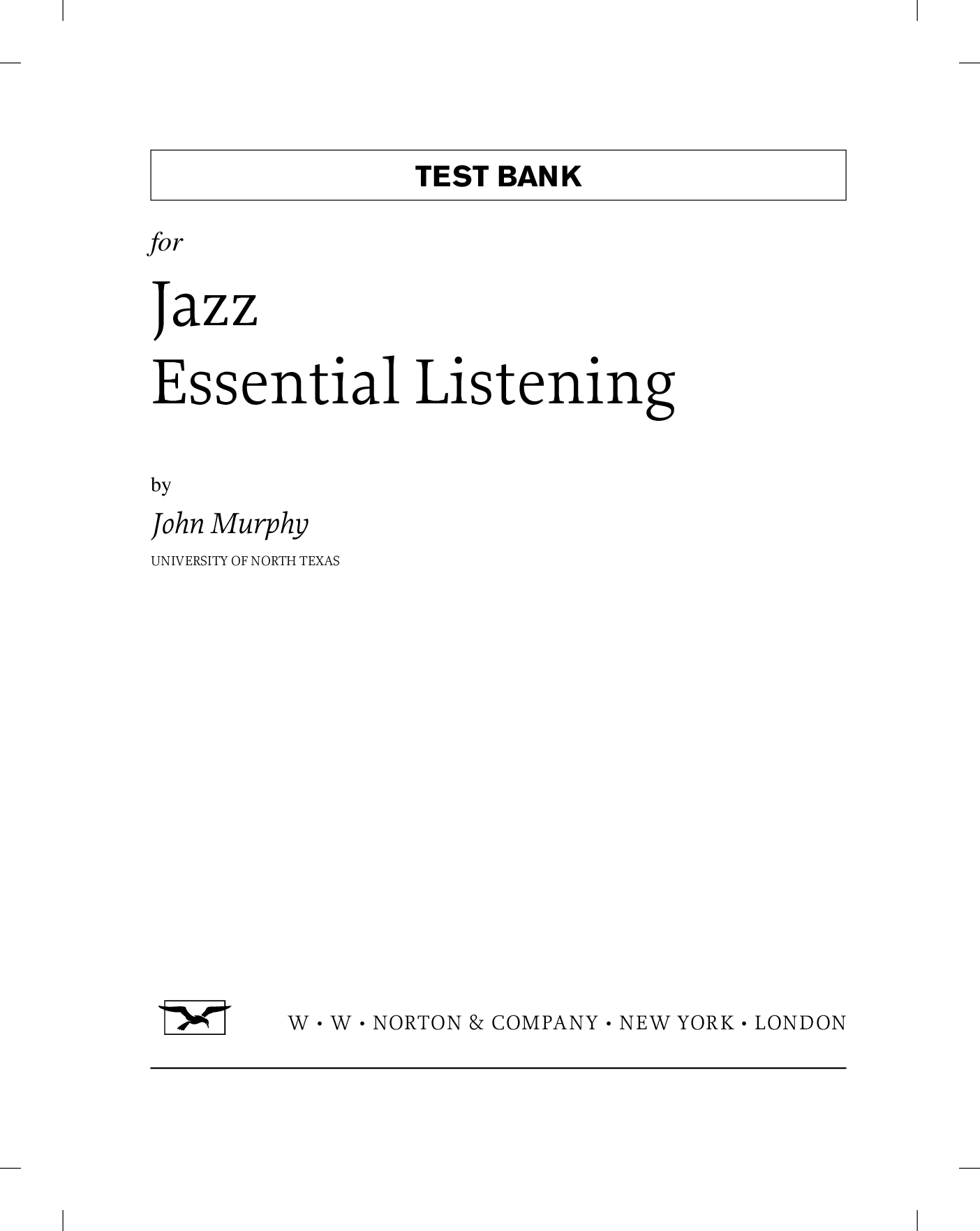
Buy this document to get the full access instantly
Instant Download Access after purchase
Add to cartInstant download
Reviews( 0 )
Document information
Connected school, study & course
About the document
Uploaded On
Dec 13, 2022
Number of pages
197
Written in
Additional information
This document has been written for:
Uploaded
Dec 13, 2022
Downloads
0
Views
66

